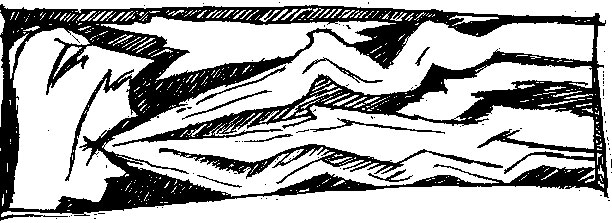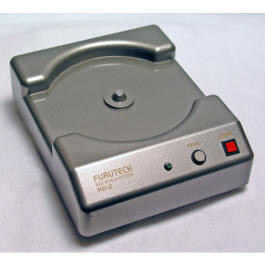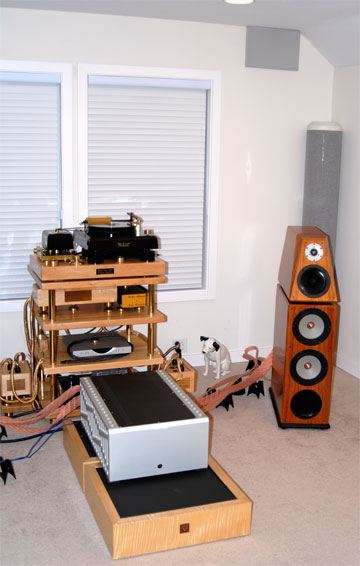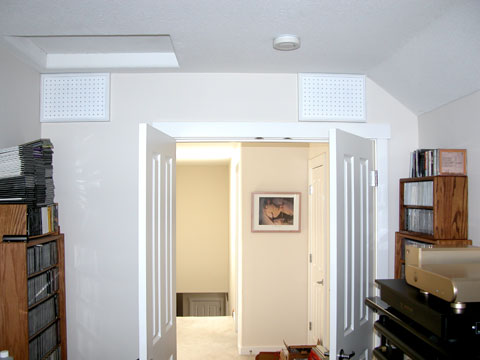|
You are reading the older HTML site
Positive Feedback
ISSUE
26
Impressions: Good Stuff!
JENA Labs 3D-X In the ever-roiling world of optical treatments and enhancers, JENA Labs has periodically come up with products of exceptional performance. One of my former benchmarks in the long-running personal epic of tweakery was JENA Labs Esoteric Mist, which was the best solution at that time, lo! some handful of years back. (Later ‘90s, as I recall.) Unfortunately, that product went out of production all too soon after it arrived, and those of us who used it treasured our last few ounces. The good news is that JENA Labs has re-entered the world of optical disc treatments with a new product, 3D-X. The better news is that there are no problems with limited supply. 3D-X is readily available in copious supply. The best news is that JENA Labs' 3D-X disc treatment is "the top o' the heap I've heard so far" for optical treatments. I've been using it with spectacular success on my SACDs, DVDs, and CDs, and checking out the results on both the EMM Labs CDSD/DCC2 Signature Edition front end (stereo SACD and CD), as well as on the Linn Unidisk 1.1/Kisto processor (surround SACD and DVD Dolby Digital/DTS). To say that I've been really pleased with the results would be an understatement; 3D-X sets a new benchmark for both audio and video excellence in my systems. 3D-X is a creamy compound containing petroleum distillates, and applies easily with the supplied pads. You place a pea-sized portion of 3D-X on the pad, and wipe it from the center of the disc to an edge. I lay down one such stripe, then another at 90 degrees to the first, and so on until I have four stripes from the center "spiral out" (NOT the center spindle hole) to the edge of the disc. Then I fill in the rest of the disc, working it in until the data area is completely covered. I follow that with a quick trip around the edge of the disc. Wait until 3D-X hazes over, then polish the edge of the disc, followed by buffing across the diameter of the disc (do NOT buff by following the circle of the disc), rotating the disc 15-20 degrees to polish every portion to a shine. When all of the haze is gone, you're ready to go. And the results? Terrific! In sum, the most notable characteristics of treated SACDs in my systems include a somewhat rounder soundstage (stereo) and soundfield (surround), and a greater harmonic richness than my other highly beloved fave rave optical treatment, Walker Audio's UltraVivid. There seems to be a deeper sense of sonic quiet beneath recordings and DVDs with the 3D-X, even compared to the UltraVivid. The cumulative effect on audio playback is striking; even non-tweakers can pick up the difference immediately, which is not always true with some products. Note that DVD playback also benefited from 3D-X, with improved color saturation and more stable deep reds, that bugaboo of DVD playback. In this latest round of optical treatments, JENA Labs has come out with a break-through product. If you are looking to squeeze every bit of performance out of your optical playback, I think that you absolutely owe it to yourself to try 3D-X, or you'll have no idea of what optical treatments can achieve. I am therefore awarding the JENA Labs 3D-X SACD/DVD/CD treatment a "Ye Olde Editor's ‘very highest recommendation!'" and that with real enthusiasm, my friends! MSRP is $80 for the basic kit, with free shipping to the lower 48 states. The basic kit includes a 4 ounce bottle of 3D-X, a package of applicator pads, a package of polishing cloths, a handy-dandy "bottle tip poker" to assure the proper size hole in the application tip, and an even handier-dandier metal "lunch box" to store it all in. Quite the setup! Note that there is an Internet special going on for this kit at this moment; for a limited time, JENA Labs is tossing in free shipping on this kit. There is also a "micro kit version" with a 2 ounce bottle and half the pads/cloths in a ziplock storage bag for $40; again, the free shipping to the lower 48. Note that JENA Labs also has a "deluxe" version of 3D-X, which includes four 4 ounce bottles of the treatment, more pads and buffing cloths, and even some of their electrical contact enhancer, which includes both the metal "lunch box" plus the larger leatherette box. The price for the deluxe model is $250; shipping/handling varies according to your location. For more details, or to place an order, see www.jenalabs.com
Furutech Disc Demagnetizer RD-2 While we're on the subject of enhancing those silver SACD/CD/DVD beasties, let me cut to the chase and recommend another product, the Furutech Disc Demagnetizer RD-2. I've been trying the degaussing of discs since the days when PFO's Clark Johnsen first wrote up the Benjamin Disc Degausser way back in the mists of Positive Feedback time. (In fact, I still have my Benjamin DD.) It showed that there was something to this strange idea of degaussing an optical audio disc. I followed that up with the Bedini Clarifier, which span the disc through a magnetic field in a hand-held device. This was an improvement, mainly due to the convenience of the holder. The Clarifier was noisy to run, however, and careless use could in theory lead to the very undesirable "Frisbee effect" as one's CD blasted off the high-speed spindle. Better than this was the Bedini Ultra Clarifier, which went to a stronger field and a horizontal tray and spindle, with a push button activator. Still noisy, but much less trouble to deal with. That's where I was until I heard of the Furutech RD-2 at CES. I put in my request to get a review unit, which was kindly handled by Jonathan Scull and Furutech. I had to wait a little while to receive it, due to production ramp-up, but it finally arrived and I have been using it on SACDs, CDs, and DVDs with abandon ever since. Before you even listen to the audio results, the immediately noticeable improvement in the RD-2 is that it is non-mechanical in operation, and thus (transports of joy) SILENT! The magnetic flux field is smoothly generated and then terminated electronically, not relying on permanent magnets and spinning mechanisms, thus allowing the RD-2's field to bathe the disc without bathos. Furutech claims that its system is superior to any approach using bar magnets/spinning shafts. It's certainly less obnoxious by orders of magnitude. Using the RD-2 is simplicity itself: you power it on, place your SACD/DVD/CD on the spindle, and press the "ERASE" button. A green light comes on, and then dims out completely when the cycle is complete. Following Furutech's recommendation, I then flip the disc over and demag the back side. That's all there is to it. I run through this procedure immediately after applying an optical treatment on my discs; the combination of the two produces a very noticeable improvement in the sound. Certainly any harsh edginess or graininess is on the audio side is knocked back; digital "glare" heads for the hills like a hyena with a pride of lions on its tail. On DVDs, there's an increased smoothness of color rendition. Frankly, I like the improvement so much that I now consider the Furutech RD-2 to be quietly indispensable; in fact, I don't listen to discs without using it any more. I've used it with both the Walker Audio UltraVivid and the JENA Labs 3D-X; it improves the effectiveness of both of those treatments. I suspect that it wouldn't matter what optical treatment you were using; the RD-2 would likely synergize with them all. Interestingly, Furutech also recommends that you use the RD-2 on CD-Rs and DVD+/-RWs before you burn the disc. (Likewise, some of my audio contacts maintain that it's a good idea to clean and optically treat CD-Rs before burning them.) I haven't tried either of these approaches yet, but I'm curious enough to give it a go the next time I'm burning some discs. Ye Olde Editor therefore gives this one a "very highly recommended!" Current MSRP of the RD-2 is USD $360. Personally, I think it's money well spent; my Bedini is now history. For more information, see www.furutech.com EMM Labs Isopath High Resolution Audio Interconnects I say "Ed Meitner" or "EMM Labs," and what passes through your mind? DSD, SACD, world-class digital playback…yes, all true. But how about cables? Yep, my friends, ees true. EMM Labs has released a new line of audio cables, their Isopath™ High Resolution Audio Interconnects. Ed sent me a couple of samples of their XLR interconnects, one of which was a 16 foot length. I intended to use this to run from my sources/preamp stacks to the main amplifier(s), which I do to keep the speaker cables shorter. The amplifiers consisted first of a pair of the excellent Lamm 1.2 hybrid monoblocks (100 WPC) for a few weeks, and then several weeks with the rather behemoth-like and awesome Boulder 2060 stereo amplifier at a beefy 600 Watts per (and 245 pounds to hoist!) The main source used for this evaluation was the EMM Labs CDSD/DCC2 Signature Edition SACD/CD playback, outputting to the Von Schweikert VR-5 SE speakers, currently under review. The 16 foot length for the Isopaths was intended as the acid test. At the site of my listening room, we are nearly 750 feet in elevation above the valley floor. I have wonderful line of site for radio and TV broadcasting—but that also means that I have some pretty (un)wonderful RF to deal with. A number of cables that I've tried simply don't have the ability to keep the RF out of the feed, including some high-performance XLRs. I had to have JENA Labs build some custom shielded XLRs to knock down the RF here. So my first question was, would the Isopaths handle this primary concern? The first test was to connect the Wavac PR-T1 preamp to the Lamm 1.2 in balanced mode. RF was marginally present at 0 gain, but not a problem in this configuration when I added one click (minimal load) to the output. There was also the very slightest touch of 60Hz, but it was well down. This was good enough for extended listening in that configuration. Later, I swapped out the Lamm 1.2 and dropped (figuratively) the Boulder 2060 stereo amplifier into place, and connected it to the WavacPR-T1's balanced outputs. The result was not good; there was a significant 60Hz buzz in the output that was unacceptable. I suspected that the interface between the Wavac and the Boulder was not compatible, and I had no intention of floating the ground on the Boulder (!). I therefore took the Wavac offline, and substituted the EMM Labs DCC2 preamp and its balanced output to the Boulder 2060. Eureka! Not to worry; completely silent operation resulted. No 60Hz hum. No RF. This allowed me to listen to the cables more carefully, and combine these impressions with those that had started to form with the Wavac PR-T1/Lamm 1.2 combination. The main virtue of the Isopaths are their clarity and detail. Certainly I would expect them to sound exceptional with the EMM Labs DCC2 SE in the path with the Boulder—and they certainly do—but I heard the same tendency with the totally different configuration of Wavac and Lamm in the mix. Ed Meitner values the same things that I do in audio reproduction, with transparency being at the top of the list. I have talked to Ed about this, and he agrees with me that transparency is probably the primary audio virtue; all other characteristics seem to derive from, or rely upon, maximum transparency to reach their full potential. Some approach this quality from the other end of the telescope, referring to "the removal of veils" to qualify this virtue; I think this to be the same thing. Put it this way: If there's too much here, here, then you can't get to the there, there; too much now makes it that much harder to touch then. Transparency in a nutshell. However you go on that subject, with the EMM Labs Isopaths, there's detail a-plenty, and the "dance of the seven veils" is down to two or three, eh? (Ed says that he's working on some projects that will strip our dancer of another veil or two—poor girl!) This transparency is not gained at the cost of lower frequencies; the bass appears to be well balanced on all SACDs that I tried. Soundstaging and imaging are excellent; both the Von Schweikert VR-5 SE and the Nova Rendition II's provide the sort of enveloping, deep soundstage that I've come to expect with SACDs and LPs, though less so with CDs. Dynamics I adjudged to be first rate at both the micro and macro levels. My conclusion: though the EMM Labs Isopath™ cables may look unassumingly workmanlike and professional-grade, they deliver truly exceptional performance at a middling (to audiophiles) price. Definitely "good stuff!" and fully meriting a "Ye Olde Editor's ‘very highly recommended!'" Superior performance, stellar transparency, a decent price, and all from one of the most respected names in fine audio—what's not to like? For more information, see www.emmcables.com, though this site will not be fully operational until some time in September, 2006. Current pricing:
For Sales or for more information, see www.emmlabs.com/html/contact/sales.html NuCore Acoustical Panels Here's a great product from a completely different vector. Long-time readers of Positive Feedback and Positive Feedback Online know that we've had a powerful interest in room acoustics and listening room acoustical devices from the very beginning—which goes all the way back to 1990. In fact, the first article we published on room acoustics was by none other than Bob Carver, all the way back in 1991. Since then, we have published a number of contributions on the subject. Personal experience? Yes, I've got that. My former room was designed with some guidance from my good friend George Cardas, and my current listening room respects certain key acoustical principles (wall within a wall on the left and right; cambered wall to ceiling interfaces on the left and right; very solid 2 x 6 construction all the way around; extremely heavy duty wooden flooring with wall-to-wall carpeting; lateral venting of both sidewalls behind the speaker positions to prevent room overload; with a resultant listening room that, despite its smaller size, is remarkably free of ringing, flutter echoes, and other fundamental audio deviltry.) To combat the acoustical blues, I have personally used devices from ASC, Michael Green/RoomTunes, and Vans Evers. My good audiobud Michael Green personally visited my former listening room on a couple of occasions, with results that we published all the way back in Positive Feeback, Vol. 7, No. 3 (pfbackissues/pfbackissues). The talented Mike Vans Evers dropped by for a weekend on one occasion, as well, to demonstrate his room tuning concepts; the results were striking and impressive, and led to further discourse by Vans Evers in PF, Vol. 7, No. 5 (pfbackissues/0705/vansevers.7n5) and Vol. 8, No. 1 (not available online at this time). Other instances come to mind; the design and construction of Winston Ma's magnificent listening room was covered in Positive Feedback, Vol. 9, No. 2. Continuation of that discussion occurred in Positive Feedback Online, Issue 1, Issue 2, and Issue 3. More recently, we've published articles from Mike Lavigne about his no-holds-barred listening room design and an ongoing series from the folks at Rives Audio. But things had been quiet on that front for quite a while—until I heard recently from an audio acquaintance that I've known for a number of years now, Andy Bartha of Nucore, Inc., located right here in the Portland area. Andy contacted me to see if I were interested in hearing a new acoustical treatment that Nucore had designed, called the Cathedral Sound Room Damping Panels (Model RDP150). These devices were made to help tame the troublesome mid-to-low frequency response of a listening room, to deal with the troublesome problems of bass waves and reverberations in the upper corners of listening rooms, and to do so at a reasonable price. According to Nucore's white paper, the product was developed "…after an extensive scientific investigation into the parameters causing undesirable reverberation, taking account of acoustic principles previously neglected in other room treatment devices. The resultant panels, when correctly positioned in the corners of a room, significantly dampen out and reduce the unwanted reverberations." I was interested, so Andy was kind enough to drop off a set of five (the proper number for my particular room configuration) for evaluation.
A Nucore Cathedral Sound Room Damping Panel, in the upper right corner just above the ASC Tube Trap; you can see that it is quite compact. Dominating the foreground is the monumental Boulder 2060 Stereo amplifier firmly ensconced on a pair of Critical Mass Grandmaster isolation stands. The Cathedral Sound Room Damping Panels are reasonably compact, measuring 11" x 16" x 2". The first prototype set that he brought in were constructed of painted pegboard style wood; the final design that he delivered a few weeks later is constructed of a wooden frame with a cloth overlay over absorbent materials. Color options are either black or white; I went with the white units. Placing the damping panels was easy enough. Andy recommended that I place one unit in each corner of my listening room; one pair on the corner walls behind the speakers, and one pair in the corner walls facing the speakers. A fifth panel was needed for the jog wall to the right rear of the listening position, where my listening room accommodates the room behind it. Mounting the units was relatively simple; since they are not particularly heavy, a single 2" wood screw driven into my walls at the appropriate balance point (there are no mounting points or hardware on the units themselves) and at the correct distance from the ceiling did the trick. When I had the Von Schweikert VR-9 SE in place, Jonathan Tinn and I took advantage of their ability to customize the bass response in my room. Using a pink noise generator, a frequency spectrum analyzer indicated that my room was fairly flat and well behaved, but that there was a slight bump in the 20 - 40Hz range. We had been able to knock that down nicely by turning down the active bass output a single notch.
Two of the prototype Nucore Cathedral Sound Room Damping Panels in the rear of my listening room. These designs were superseded by the cloth covered final products that you saw in the previous image. Once the VR-9 SE left, however, to be replaced by the VR-5 SE, I lost the ability to tweak out the bass response via the speaker itself. Enter the Nucore panels at a very providential moment. Their white paper's frequency response waterfalls indicated that I could expect a helping hand in this very frequency range. I had nothing to lose, so let necessity be the mother of invention. The results were immediately noticeable, and quite gratifying, once I had five panels in place. The VR-5 SE—which have excellent lower-end frequency response, being down -2 dB at 30Hz and -4 dB at 20Hz, went from overdriving the room somewhat at normal listening volumes, to a much more pleasing integration of the deep bass. I haven't had a chance to check my listening impressions with a good frequency analyzer yet, and so can't be categorical in my comments here, but my definite impression is that Nucore's waterfall graphs (showing a significant knock-down effect in the 20 - 56Hz range) roughly match what I am hearing. Certainly, I am not hearing any boominess in my room with the VR-5 SE at normal listening volumes since the Cathedral Sound Room Damping Panels arrived. Unfortunately, Nucore's white paper and the graphs I am referring to have not yet been posted on the Nucore web site. Perhaps David De Thier, Andy Bartha and company will remedy this shortcoming in the near future by publishing a .PDF; it would be useful to have their analysis online. I have some additional Nucore damping panels on hand; I may experiment with some additional placements that Andy suggested. If so, I'll report any results to our readers in a future issue. Pricing for these little honeys is very reasonable: $179.99 per pair, with two pair recommended as a minimum for your standard four upper corner room. Excellent bang for the buck here; the four pairs that I have here at PFO Central will not be leaving, that's for sure. I therefore give the Nucore Cathedral Sound Room Damping Panels a "Ye Olde Editor's rating of ‘Highly recommended!'" Audiophiles interested in getting the most out of their room acoustics while on a budget will want to give this product serious consideration. For more information, or to purchase sets of the Cathedral Sound Room Damping Panels:
Nucore, Inc.
|




